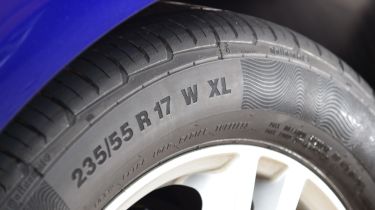Tyre speed ratings explained: chart, rating letters and what they mean
Tyre speed ratings can be confusing. Heres a guide on what these mean.

Even if you’re on the ball with making sure your car’s tyres are in good condition and correctly inflated, you might not spend a great deal of time reading what’s on the tyre sidewall.
There’s some useful information on there, though, and not just when it comes to choosing the correct size of tyre. One of the most crucial, but often overlooked details is the tyre speed rating, a small code that indicates whether the tyre is suitable for your car’s performance levels.
Where to find your tyre speed rating
The tyre speed rating is very simple to find. It’s a single letter at the very end of your tyre size code, following the tyre size code, and the load rating code.
Taking a new Volkswagen Golf GTI as an example, a car on standard 18-inch wheels will have a tyre size code of 225/40 ZR18. After this, you’ll find a two-digit number for the load rating (such as ‘92’), and the letter right after this – for the GTI, a ‘Y’ in standard form – is the tyre speed rating code.
Why are tyre speed ratings important?
Your tyre speed rating is effectively an indication of how capable the tyre is of standing up to the huge demands of travelling at high speeds. On the move, a tyre is subject to the forces of friction from the road surface, and this generates a lot of energy, particularly at high speeds – which in turn generates a lot of heat. You may notice this if you’ve ever touched your tyres after a long motorway drive.
While tyres are designed to stand up to this heat, there is a large range of models on the market with different levels of performance, and different weights too, which place different demands on the rubber. Tyres rated for 200mph on a car that barely tops 100mph would be overkill and ultimately cost the consumer money for a product whose capabilities they’d never use.
Equally, fitting a tyre to your car with a speed rating below the car’s performance capabilities means it might not stand up to the demands of driving quickly. It goes without saying that you don’t want this to happen at higher speeds. So like most aspects of tyre safety, the speed rating is very important. If your car is partiuclarly powerful, it might be worth considering dedicated performance tyres.
What does the speed rating mean?
The current speed rating system is alphabetical, though confusingly not all the letters are in order. Below is a table showing the tyre speed ratings you’ll most commonly see on road cars (the scale starts from A1, though as a car owner you’re unlikely to see a tyre rated for only 3mph…). We’ve also included their maximum speeds in both kilometres per hour (the speeds against which the scale is calibrated), and their equivalents in miles per hour.
As even the 30mph Citroen Ami has T-rated tyres, we’ve started our scale from L, for 75mph and up.
| Speed rating letter | Speed in kmh | Speed in mph |
| L | 120 | 75 |
| M | 130 | 81 |
| N | 140 | 87 |
| P | 150 | 93 |
| Q | 160 | 100 |
| R | 170 | 106 |
| S | 180 | 112 |
| T | 190 | 118 |
| U | 200 | 124 |
| H | 210 | 130 |
| V | 240 | 149 |
| W | 168 | 168 |
| Y | 186 | 186 |
As most modern cars comfortably top 100mph, and speed ratings usually give quite some headroom above a car’s theoretical top speed, there won’t be many cars with tyres rated at less than ‘T’ today. A 62bhp Kia Picanto, for instance, has a top speed of 90mph, but its standard 185/65 R14 tyres have a ‘T’ speed rating, good for 118mph.
Tyres sold in Europe are tested in controlled conditions to ensure they’re capable of running at different speeds for different periods of time.
How do I choose the right tyre speed rating?
The good news is that while it’s useful to know your tyre speed rating, you shouldn’t need to pay it too much attention when buying a new set of tyres. The tyre manufacturers themselves know the importance of speed ratings and if you’re buying a new set, the chances are highly likely that if you’ve got tyres of the correct size for your car, the speed rating will already be more than suitable for its performance.
That includes other aspects of the car’s ability too, since a car designed for higher-performance vehicles (or heavier vehicles like SUVs) won’t just be safer at higher speeds, but is also likely to have cornering performance and wear rates appropriate for the car too.
The possible exception here is with ultra budget rubber, as little-known and less reputable brands may cut corners to preserve their profit margins. If you absolutely must buy the cheapest possible tyres for your car, it’s worth double checking the speed rating.
And if you wish, you can of course fit tyres with a much higher speed rating to your car with no ill effects – you’ll likely just pay more for the privilege. The only golden rule is never to fit a tyre with a speed rating below your car’s abilities. Not only is this potentially unsafe, but it can also invalidate your car insurance.
Subscribe to the UK's favourite car magazine: get Auto Express delivered every week...
Find a car with the experts





